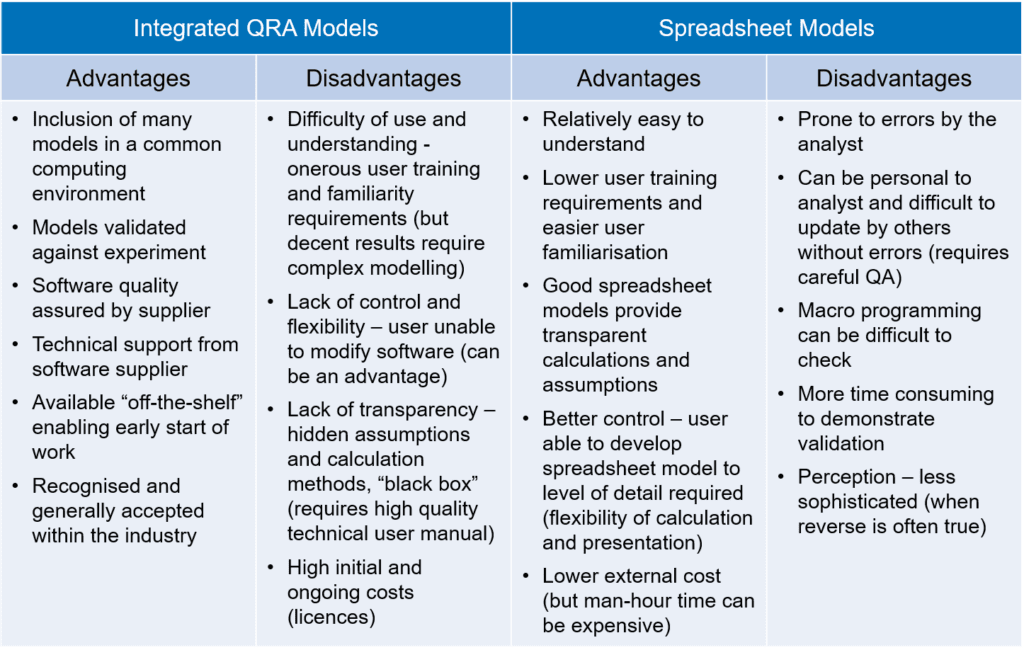Which QRA software?
In 2004 Risktec completed a comprehensive survey of software currently available for undertaking quantitative risk assessment (QRA) for onshore and offshore oil and gas facilities. The key requirement was that the software had to be available to users under licence, with full user support. This immediately removed from the search any “in-house” tools developed by consultants.
From an initial list of over 80 tools, only a handful of software products were found that could undertake full QRA. Also, offshore and onshore QRA tools tend to be packaged separately, reflecting the different characteristics that need to be modelled, e.g. offshore evacuation, or onshore far field impact on the public. What is clear is that there is no single “best” tool designed for both offshore and onshore QRA.
KEY FINDINGS
- There are no commercially available tools for “coarse” QRA at concept selection stage, but some consultants have in-house models.
- There is no single fully “integrated” offshore tool. In practice, most companies develop bespoke, installation – specific, linked spreadsheet models – see Fig 1.
- Onshore is better served and software products are generally well used and accepted. Non-hydrocarbon/ chemical risks (e.g. transport) still need to be quantified “off-line”, though they tend to be less critical onshore than offshore.
- A handful of products stand out as technical leaders – see Fig 2.
Fig.1 Integrated QRA models versus spreadsheet models

Note 1 – “Computational workbench” linking modules to MS Excel/VBA
Note 2 – Concentrates on escalation of fire and explosion events taking account of geometry
Note 3 – Incorporates PHAST physical effects tool
Note 4 – FRED physical effects tool is part of suite but user is not constrained to using it
Note 5 – “integrated” means that most calculations are done “on-line” within software rather than “off-line” by other tools. SAFETI is arguably more integrated than SHEPHERD
A WORD OF WARNING
With apologies to the Lonely Planet guide books:
“Software always changes – good software usually gets better but sometimes gets left behind, poor software usually goes out of business, new software gets launched, names change – nothing stays the same”
2015 UPDATE
Whilst the original 2004 formal survey has not been updated, unsurprisingly by 2015 there have been some significant changes in the market, for example:
- Safeti Offshore is now available for offshore QRA and supersedes Neptune.
- Plato for offshore QRA and Riskplot for onshore QRA are no longer available on the market.
- Safeti for onshore QRA did change its name to PhastRisk but more recently changed its name again to Safeti Onshore.
- Shepherd for onshore QRA is only available for use on Shell projects.
- Riskcurves is now a fully integrated solution for onshore QRA, incorporating the Effects consequence modelling software which itself now includes the Damage software.
- There are some new entrants to the onshore QRA market such as HAMS-GPS, though these do not appear to be widely used.
KEY SELECTION CRITERIA
Key factors to consider when selecting QRA software include:
- Scope – what exactly do you want to model and in how much detail? Can the software meet your requirements or will you be overwhelmed by the functionality?
- Repeatability and transparency – are the methods, rule sets and data visible and traceable?
- Cost – how much will licences, training, in-house time and external consultants cost over the long-run?
- Integration – how easy will it be to integrate the processes for managing the software and assessments into your company’s management system?
RISKTEC VERDICT
With apologies to the Top Gear car magazine:
Risktec survey – the choice is limited and there is plenty of scope for improvement in the software currently on the market.
Risktec choice – spreadsheets for offshore. For onshore, either Safeti Onshore or Riskcurves for more complex onshore studies because users have the flexibility to enter results from their preferred physical effects tool.
Don’t be fooled by – good looks. Users want flexibility and transparency in methods, rule sets and data.
CONCLUSION
Users need to consider very carefully their requirements before selecting specific software.
Often, using one of the onshore products is the best way to proceed. But the complexities of modelling offshore risks mean that most organisations develop their own spreadsheet models to utilise the methods, assumptions and data they understand to an appropriate level of detail.
Organisations with multiple facilities who want a flexible but more robust approach than spreadsheets, have an alternative cost-effective option: to develop their own bespoke model making use of Microsoft development tools or equivalent.
The original version of this article first appeared in RISKworld Issue 7.








